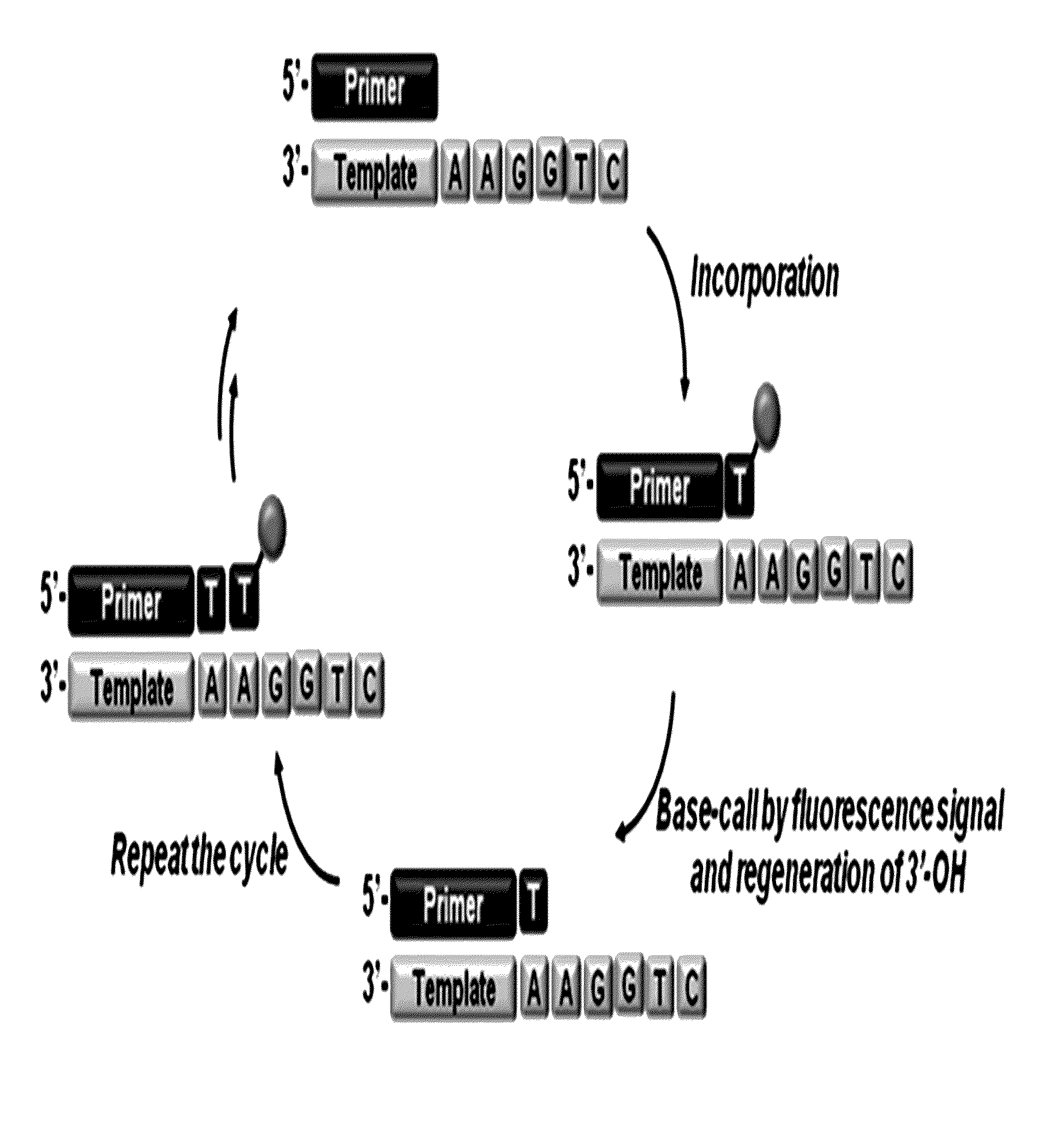3'-o-fluorescently modified nucleotides and uses thereof
a fluorescently modified, nucleotide technology, applied in the field of nucleoside triphos, can solve the problems of limiting the number of sequenced bases, increasing the chance of errors in profiling polynucleotide fragments, and prior arts that are not suitable for use in sbs in efficiency and fidelity, and achieves higher yield and high efficiency for continuous polymerization
- Summary
- Abstract
- Description
- Claims
- Application Information
AI Technical Summary
Benefits of technology
Problems solved by technology
Method used
Image
Examples
example 1
Synthesis of 3′-O-(7-hydroxycoumarin)-dTTP, the Mono-Modified Reversible Terminator (MRT)
Synthesis of Compound 2
[0072]To a solution of 1,5-pentanediol (66.9 mmol) and tert-butyldimethylsilyl chloride (TBSCl, 66.9 mmol) in dichloromethane (100 mL) was added triethylamine (100.4 mmol). The reaction mixture was stirred for 5 min at room temperature. The reaction mixture was diluted with dichloromethane, washed with water, dried over anhydrous MgSO4, and concentrated using rotary evaporator. The residue was purified by column chromatography (silica gel, hexane / ethyl acetate=10 / 1) to give the target compound as a colorless oil (95% yield).
[0073]The obtained compound was analyzed by NMR and the results are as follows: 1H NMR (300 MHz, CDCl3) d 3.63-3.58 (m, 4H), 1.59-1.49 (m, 4H), 1.41-1.35 (m, 2H), 0.87 (s, 9H), 0.03 (s, 6H) ppm; 13C NMR (75 MHz, CDCl3) δ 63.4,62.7, 32.7, 32.6, 26.2, 22.2, 18.6, −5.1 ppm; IR(KBr) 3348, 2932, 2859, 1472, 1389, 1362, 1255, 1102, 1006, 939, 836, 775 cm−1;...
example 2
Extension of DNA Primer with MRT
[0096]The polymerase extension reaction by polymerase was performed in 20 mL of reaction mixture containing 5 mM of a biotinylated primer (5′-biotin-GCTACGACTCACTATGGACG-3′, SEQ. ID. NO: 1), 5 mM of the template (5′-CGTCCATAGTGAGTCGTAGC-3′, SEQ. ID. NO: 2, a complementary base to an inserted base is underlined and bolded), 200 mM of 3′-O-(7-hydroxycoumarin)-dTTP (MRT, compound 13), 1×ThermoPol II reaction buffer (20 mM Tris-HCl / 10 mM (NH4)2SO4 / 10 mM KCl / 2 mM MnCl2 / 0.1% Triton X-100, pH 8.8, New England Biolabs, Inc.), and 4 units of Therminator II DNA polymerase. The reaction was consisted of 20 cycles at 94° C. for 20 sec, 46° C. for 40 sec, and 60°-0 C. for 90 sec. After the reaction, the mixture was incubated with strepatavidin-coated magnetic beads (100 mg, Dynabead MyOne, Invitrogen) in PBS buffer (200 mL) at room temperature for 30 min. The DNA immobilized on beads were then washed twice with 200 mL deionized water and eluted with 40 mL biotin s...
example 3
Sequencing of Inserted Base Sequence Using 3′-End Fluorescence Label
[0098]The DNA immobilized on magnetic beads obtained in Example 2 was eluted with 40 mL biotin solution (1 mM in deionized water / DMSO=98 / 2), and diluted with 360 mL Tris-HCl buffer (50 mM, pH=8.0). The fluorescence intensity of the solution was measured using LB50B luminescence spectrometer (Perkin-Elmer, Waltham, USA) (excitation at 316 nm). For the control, fluorescence intensity of the reaction mixture without Therminator II DNA polymerase was measured using the same manner as described in Example 2.
[0099]As a result, as shown in FIG. 4, the fluorescence signal (dotted line) of the extended primer emitted from the fluorescent group conjugated to the MRT after polymerization with the MRT increased, compared with that of the primer before the reaction (FIG. 4). The above result indicates that the MRT linked fluorescence label can be used for sequencing of bases inserted in the primer by polymerase.
PUM
| Property | Measurement | Unit |
|---|---|---|
| Fluorescence | aaaaa | aaaaa |
Abstract
Description
Claims
Application Information
 Login to View More
Login to View More - R&D
- Intellectual Property
- Life Sciences
- Materials
- Tech Scout
- Unparalleled Data Quality
- Higher Quality Content
- 60% Fewer Hallucinations
Browse by: Latest US Patents, China's latest patents, Technical Efficacy Thesaurus, Application Domain, Technology Topic, Popular Technical Reports.
© 2025 PatSnap. All rights reserved.Legal|Privacy policy|Modern Slavery Act Transparency Statement|Sitemap|About US| Contact US: help@patsnap.com



